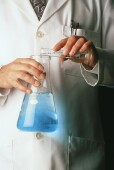Researchers Create Protective Sac for Growing Stem Cells
Miniature lab would carry therapeutic cells to their destination in the body.
|
E-mail this article
Subscribe to news
Printer friendly version
|

(SOURCE: Northwestern University, news release, March 27, 2008)
THURSDAY, March 27 (HealthDay News) -- A "mini stem cell lab" created by U.S. researchers holds promise for use in cell therapy and other biological applications, as well as in the design of certain kinds of electronic devices and new materials.
The team at the Institute for BioNanotechnology in Medicine at Northwestern University in Evanston, Ill. uses one polymer and one small molecule that instantly assemble into a flexible but strong sac that creates a "miniature laboratory" in which human stem cells can be grown.
When used in cell therapy, this sac could protect stem cells from the body's immune system until the stem cells reach their destination. The sac would then biodegrade and release the stem cells to do their work, the researchers said.
In tests, they've demonstrated that human stem cells will grow in the sacs, that the sacs can survive for weeks in culture, and that proteins, even large ones, can travel freely across the sac membranes.
The research is described in the March 28 issue of Science.
The Northwestern team also said this method can produce thin films with tailored sizes and shapes, and may have applications in the design of electronic devices by self-assembly (such as solar cells), and the design of new materials.
"We started with two molecules of interest, dissolved in water, and brought the two solutions together," research leader Samuel I. Stupp, a professor of materials science and engineering, chemistry and medicine, said in a prepared statement.
"We expected them to mix, but, much to our surprise, they formed a solid membrane instantly on contact. This was an exciting discovery, and we then proceeded to investigate why it happened. Understanding the surprising molecular mechanism was even more exciting," Stupp said.
One of the molecules is a peptide amphiphile, synthetic molecules developed by Stupp seven years ago that are essential in his work on regenerative medicine. The other molecule is the biopolymer hyaluronic acid, readily found in the human body in places such as joints and cartilage.
More information
The U.S. National Institutes of Health has more about stem cells.
Copyright © 2008 ScoutNews, LLC. All rights reserved. 
HealthDayNews articles are derived from various sources and do not reflect federal policy. healthfinder.gov does not endorse opinions, products, or services that may appear in news stories. For more information on health topics in the news, visit the healthfinder.gov health library.